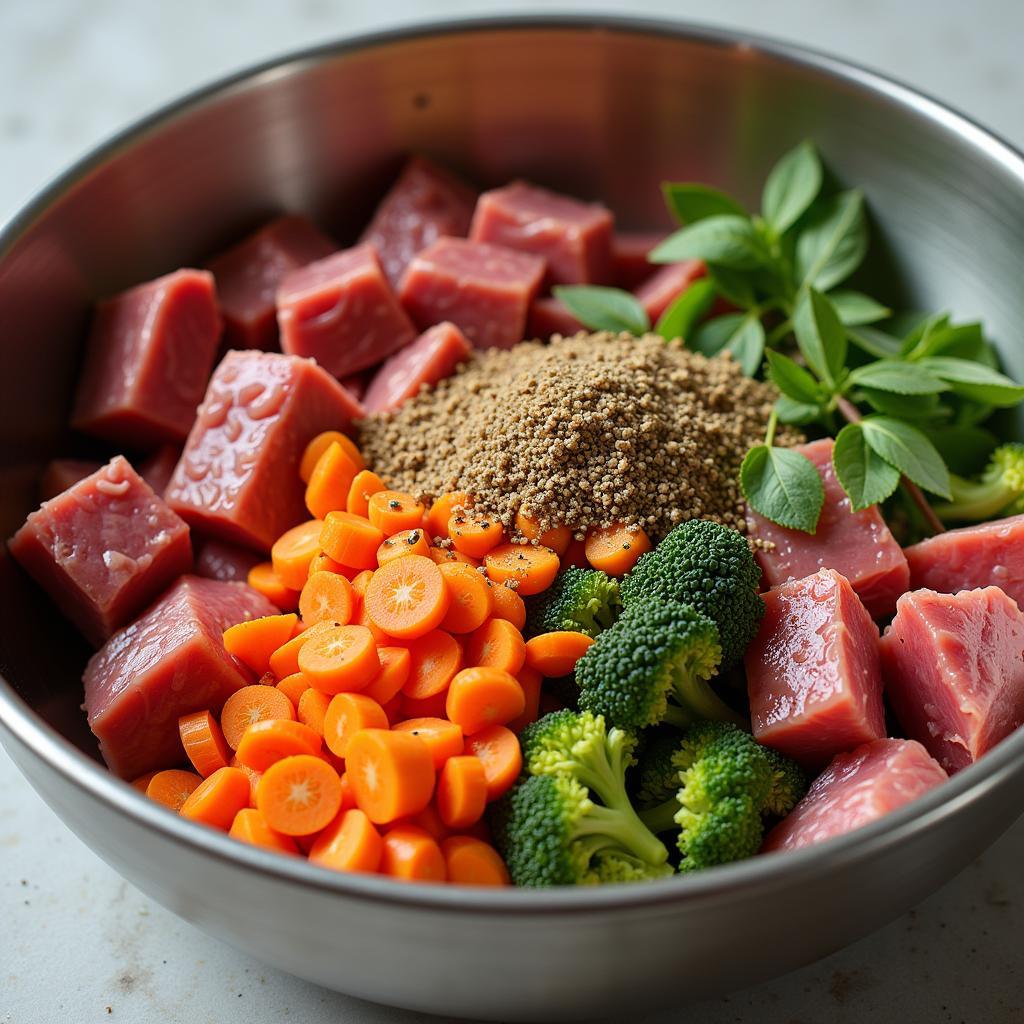Raw Blends Dog Food has taken the pet world by storm, offering a natural and potentially healthier alternative to traditional kibble. But what exactly is it, and is it the right choice for your furry friend? Let’s delve into the fascinating world of raw blends and explore its benefits, drawbacks, and everything in between.
What is Raw Blends Dog Food?
 Raw Blends Dog Food Ingredients
Raw Blends Dog Food Ingredients
Raw blends dog food, as the name suggests, is a raw diet consisting of uncooked ingredients blended together. Unlike commercially produced kibble, which undergoes high-heat processing, raw blends preserve the natural enzymes, vitamins, and nutrients often lost during cooking.
This type of dog food typically includes a mix of:
- Muscle meat: Chicken, beef, turkey, lamb, fish
- Organ meat: Liver, kidney, heart
- Bones (ground or whole): A natural source of calcium
- Fruits and vegetables: Apples, blueberries, spinach, carrots
- Other additions: Eggs, yogurt, kefir, supplements like dog food supplement powder
The Allure of a Raw Diet: Benefits of Raw Blends
Proponents of raw blends often cite a range of benefits, including:
- Improved digestion: Raw food is believed to be easier for dogs to digest due to the presence of natural enzymes.
- Shinier coat and healthier skin: The abundance of nutrients in raw blends can contribute to a healthier coat and skin.
- Increased energy levels: Many dog owners report a noticeable boost in their dog’s energy levels after switching to a raw diet.
- Dental health: Chewing on raw meaty bones can help clean teeth and improve dental hygiene.
Navigating the Concerns: Potential Risks of Raw Blends
While the benefits are enticing, it’s essential to be aware of the potential drawbacks of feeding raw blends:
- Bacterial contamination: Raw meat can harbor harmful bacteria like Salmonella and E. coli, posing risks to both dogs and humans.
- Nutritional imbalances: Formulating a balanced raw diet requires careful planning and knowledge.
- Cost and convenience: Raw blends can be expensive and require more preparation time than kibble.
- Choking hazards: Whole bones, if not fed with caution, can pose a choking hazard, especially for small dogs or aggressive chewers.
Is Raw Blends Right for Your Canine Companion?
Deciding whether to switch to raw blends dog food is a personal choice that depends on your dog’s individual needs and your lifestyle.
 Veterinarian Consultation
Veterinarian Consultation
Here’s what to consider:
- Consult your veterinarian: Before making any dietary changes, always consult with your vet to assess your dog’s specific needs and health conditions.
- Source ingredients carefully: Opt for high-quality, human-grade ingredients from reputable suppliers to minimize the risk of bacterial contamination.
- Transition gradually: Introduce raw blends slowly over several days to allow your dog’s digestive system to adjust.
- Practice safe handling: Wash your hands thoroughly after handling raw meat and disinfect surfaces to prevent bacterial contamination.
Myths and Misconceptions about Raw Blends
There are several myths surrounding raw blends dog food. Let’s debunk some of the most common ones:
Myth 1: Raw meat makes dogs aggressive.
Fact: There is no scientific evidence to support this claim. Aggression in dogs is influenced by various factors, including breed, socialization, and individual temperament.
Myth 2: Raw bones are dangerous for dogs.
Fact: Raw meaty bones are a natural part of a dog’s diet and can be beneficial for dental health. However, it’s crucial to choose bones that are appropriately sized for your dog and supervise chewing to prevent choking.
Myth 3: Raw blends are a complete and balanced diet.
Fact: While raw blends can provide a wide range of nutrients, it’s essential to ensure they meet all of your dog’s nutritional requirements. Consider working with a veterinary nutritionist to create a balanced meal plan.
Exploring Other Options: Kibble vs. Raw Blends
 Dog Food Comparison
Dog Food Comparison
While raw blends offer potential benefits, traditional kibble remains a popular choice for many dog owners. Let’s compare:
Kibble:
- Pros: Convenient, affordable, readily available, often fortified with vitamins and minerals.
- Cons: Can be highly processed, may contain artificial ingredients, may not be as palatable as raw food.
Raw Blends:
- Pros: Minimally processed, preserves natural nutrients, can improve digestion and skin health.
- Cons: Requires careful preparation, can be expensive, risk of bacterial contamination.
Ultimately, the best choice for your dog depends on their individual needs, your lifestyle, and your preferences.
Conclusion
Raw blends dog food offers a natural and potentially beneficial approach to canine nutrition. However, it’s not without its risks and considerations. By understanding the pros and cons, consulting with your veterinarian, and practicing safe handling, you can make an informed decision about whether raw blends are the right fit for your furry friend. Remember, a healthy and happy dog starts with a balanced and appropriate diet.
FAQs
1. Can puppies eat raw blends?
Yes, puppies can thrive on raw blends, but it’s crucial to adjust the diet to their specific nutritional needs for growth and development. Consult with your veterinarian for guidance.
2. How do I store raw blends dog food?
Store raw blends in the freezer and thaw only the amount you need for each meal. Keep thawed food refrigerated and discard any leftovers after 24 hours.
3. Where can I buy raw blends dog food?
You can find raw blends at some pet stores, specialty retailers, and online. Look for reputable brands that use high-quality ingredients and follow strict safety standards.
4. Can I mix raw blends with kibble?
While some dog owners choose to mix raw blends with kibble, it’s generally not recommended as the two types of food digest at different rates. This can lead to digestive upset in some dogs.
5. Are there any alternatives to raw blends if I’m concerned about bacteria?
Yes, commercially produced raw food that has been high-pressure processed (HPP) to eliminate bacteria is available. You can also consider adding a [nutrient mix for homemade dog food](https://minacones.com/nutrient mix-for-homemade-dog-food/) to cooked meals for added nutrition.
For additional questions or support, our dedicated team is here to help! You can reach us 24/7 at Phone Number: 02437655121, Email: minacones@gmail.com, or visit us at 3PGH+8R9, ĐT70A, thôn Trung, Bắc Từ Liêm, Hà Nội, Việt Nam.